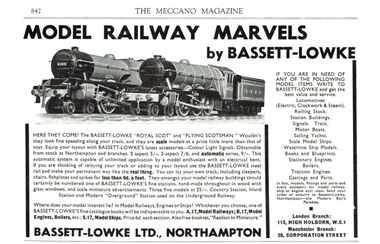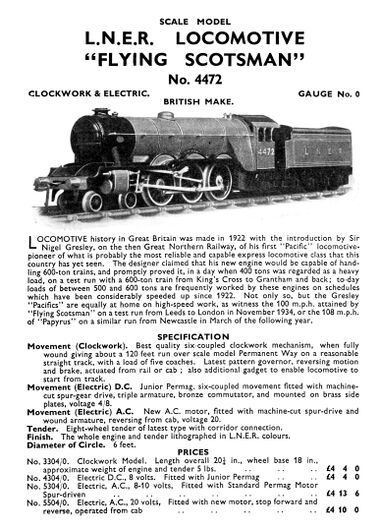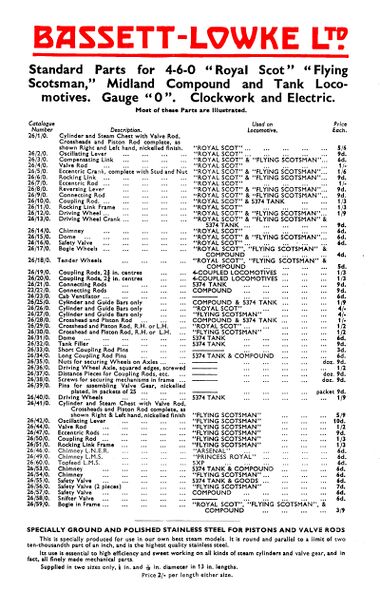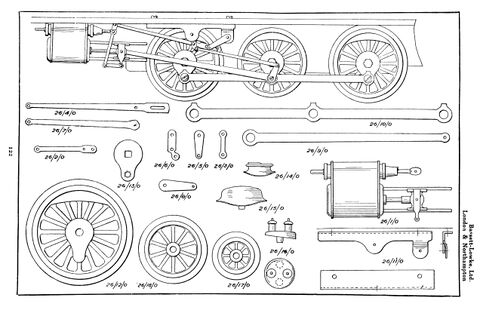Flying Scotsman locomotive, gauge 0, LNER 4472 (Bassett-Lowke)
| Exhibit |
|---|
Flying Scotsman locomotive, gauge 0, LNER 4472 (Bassett-Lowke)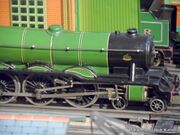 Bassett-Lowke LNER 4472 "Flying Scotsman" (i) Bassett-Lowke LNER 4472 "Flying Scotsman" (i)
|
 |
| location: |
|
Arch Three , Area 1 1930s |
Bassett-Lowke "Flying Scotsman" and "Royal Scot" locomotives, ~1930s [image info]
Bassett-Lowke Flying Scotsman model, 1937 [image info]
Parts list [image info]
A green electric model LNER 4-6-2 gauge 0 locomotive 4472 Flying Scotsman and tender, made by Bassett-Lowke in the 1930s.
In the mid-1930s, the two express passenger locos that everybody in the UK was interested were the green LNER Flying Scotsman and the red LMS Royal Scot, and Bassett-Lowke promoted their models of both locos together, offering them as a simple choice depending on whether you wanted your model railway to be LNER or LMS (or, for people who were less serious about railways, whether you preferred your expensive model passenger loco to be green or red).
As well as selling this popular model in clockwork and electric versions, Bassett-Lowke also made the critical "Scotsman" parts available, "loose", for people who preferred to build their own model locomotives but didn't fancy the prospect of having to hand-engineer critical components such as wheels, cylinders and drive gear themselves.
"Detail" picture
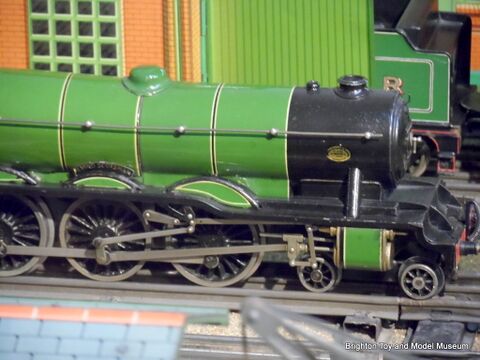
Parts
A page from the 1937 catalogue, showing a range of gauge 0 "Scotsman" parts available separately.
1937 publicity text:
LOCOMOTIVE history in Great Britain was made in 1922 with the introduction by Sir Nigel Gresley, on the great Northern railway, of his first "Pacific" locomotive – pioneer of what is probably the most reliable and capable express locomotive class that this country has yet seen.
The designer claimed that the new engine would be capable of handling 600-ton trains, and promptly proved it, in a day when 400 tons was regarded as a heavy load, on a test run with a 600-ton train from King's Cross to Grantham and back; to-day loads between 500 and 600 tons are frequently worked by these engines on schedules which have been considerably speeded up since 1922. Not only so, but the Gresley "Pacifics" are equally at home on high-speed work, as witness the 100 m.p.h. attained by "Flying Scotsman" on a test run from Leeds to London in November 1934, or the 108 m.p.h. of "Papyrus" on a similar run from Newcastle in March of the following year.
— , -, , Bassett-Lowke catalogue, , 1937
1937 Specification
- Movement (Clockwork).
- Best quality six-coupled clockwork mechanism, when fully wound giving about a 120 feet run over scale model Permanent Way on a reasonable straight track, with a load of five coaches. Latest pattern governor, reversing motion and brake, actuated from rail or cab; also additional gadget to enable locomotive to start from track.
- Movement (Electric) D.C.
- Junior Permag. six-coupled movement fitted with machine-cut spur-gear drive, triple armature, bronze commutator, and mounted on brass side plates, voltage 4/8.
- Movement (Electric) A.C.
- New A.C. motor, fitted with machine-cut spur-drive and wound armature, reversing from cab, voltage 20.
- Tender.
- Eight-wheel tender of latest type with corridor connection.
- Finish.
- The whole engine and tender lithographed in L.N.E.R. colours.
- Diameter of Circle.
- 6 feet.
Prices
- No. 3304/0. – Clockwork Model. Length overall 20 1/4 in., wheel base 18 in., approximate weight of engine and tender 5 lbs. .. .. £4-4-0
- No. 4304/0. Electric D.C., 8 volts. Fitted with Junior Permag .. .. £ 4-4-0
- No. 5304/0. Electric, A.C., 8-10 volts, Fitted with Standard Permag Motor Spur-driven .. .. £4-13-6
- No. 5504/0. Electric, A.C., 20 volts, Fitted with new motor, stop forward and reverse, operated from cab .. .. £4-10-0
